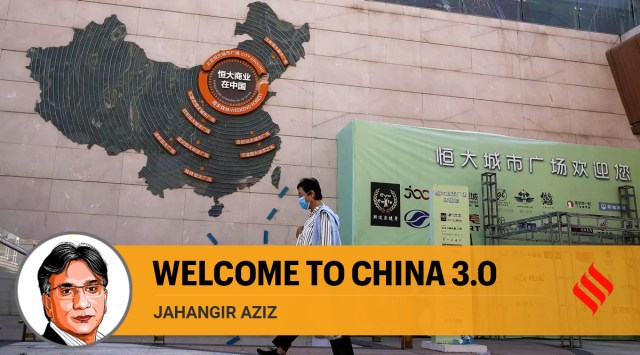- India
- International
Why China has decided against saving Evergrande
Jahangir Aziz writes: It is the strongest signal yet that no corporate is ‘too big to fail’ and that there are no state guarantees for them.
 A woman wearing a face mask to help protect herself from the coronavirus walks by a map showing Evergrande development projects in China, at an Evergrande city plaza in Beijing (AP)
A woman wearing a face mask to help protect herself from the coronavirus walks by a map showing Evergrande development projects in China, at an Evergrande city plaza in Beijing (AP)In evaluating the 2017 19th Communist Party (CCP) conference, we had stated that it would turn out to be China’s watershed moment (IE, November 3, 2017). While media and market attention was focused on the elimination of the 10-year term limit for Party leadership and the presidency, we viewed the restating of the “principal contradiction” facing China by the CCP as being more important.
The notion of principal contradiction is central to how the Party sees the economy, politics, and society. Given the dominance of the Party, this, in turn, sets out the overarching framework for policies at all levels of government. After the economic destruction resulting from the Cultural Revolution, the 1981 Congress under Deng Xiaoping restated the “principal contradiction” as the tension “between the ever-growing material needs of the people and backward social productivity” instead of the “class struggle between the proletariat and the bourgeoisie” as identified by Mao Zedong. To resolve this contradiction, policies were changed and the economy reformed to deliver and sustain a stunning 10 per cent average growth over the next three decades. But the growth also brought with it extensive collateral damage, ranging from high leverage to severe environmental degradation. While in 2010 the central government initiated a process to rebalance the economy, progress on the ground was slow; often circumvented by local administrations still operating under the Party objective of focusing on growth and employment.
To align the objectives of the Party and that of all levels of government, the 2017 Congress restated the principal contradiction as the tension between “unbalanced and inadequate development” and the “peoples’ ever-growing need for a better life”. This radically altered how the Party saw China: No longer a low-income economy needing to generate millions of new jobs every year to maintain social stability, but a rising middle-income nation aspiring for a better quality of life. The new CCP framework, we assessed, would have as dramatic an impact as the 1981 restatement did — growth would be slowed, regulations tightened, and leverage reined in.
This scenario has broadly played out since 2018, despite two large shocks — heightened tensions with the US and the pandemic. We view the relatively tight fiscal and monetary policies; the persistent tightening in the housing market; the re-designation of private tutorials as non-profit; the economy-wide push to de-carbonise; and letting corporates with weak balance sheets to default, as elements of the regime change foretold at the 19th Party Congress. In its latest version, the policy changes are couched in terms of the “Common Prosperity” objectives.
So where does the credit stress in Evergrande fit into all this? It is another manifestation of the regime change underway, albeit with one big difference. The market would have taken the stress in its stride (as it has the increasing frequency of defaults over the last three years) if this was a run-of-the-mill property company or a mid-sized bank. But Evergrande is the biggest property developer in China and among the largest in the world. Given the size, it is not unreasonable to fear that the direct impact or the financial contagion can be large. However, such fears are overstated. First, while still a substantial part of the economy, the real estate sector’s contribution to the post-pandemic recovery has been modest. In addition, there was no expectation of a significant turnaround in this sector to buoy the recovery in 2022. Consequently, the impact on growth is likely to be limited. Second, the financial liabilities of the company, while large in absolute terms, make up about 0.65 per cent of China’s corporate and government debt combined (the stock of total social financing) and bank loans per se just 0.25 per cent of total bank credit. Linkages to offshore banks and financial institutions are even smaller.

That said, all is not well with the property sector. Balance sheets of many property developers have also weakened in the past few years because of the policy-induced slowdown in sales and prices. Stress tests suggest that the banking sector can be challenged if default rates reach historical highs. However, China’s banks, on average, are well provisioned and capitalised. And importantly, authorities are unlikely to allow a large-scale credit event to unfold. Despite China’s very high debt stock (close to 300 per cent of GDP), the government and central bank still retain sufficient policy space to ensure that such system-wide stress is avoided.
So why did the authorities not intervene to prevent the collapse of Evergrande? Because not doing so is the strongest signal yet that no corporate is “too big to fail” and that there are no state guarantees for them. For years, investors and analysts (including multilateral institutions) have exhorted China to allow defaults as a way of eliminating the market’s presumption of implicit state guarantees, which has obfuscated any meaningful distinction between good and bad credit leading to a distorted allocation of capital and substantial loss of efficiency. While there could be short-term pains and even some spillover into the wider financial system, over the medium term this “inaction” is likely to improve the pricing of credit and efficiency of capital.
While we expect the Chinese economy to recover in the coming quarters from likely near-zero sequential growth in 3Q (on a year-on-year basis, growth should remain above 6 per cent), over the medium term, growth is headed to the 4-5 per cent range, with significant rebalancing of the growth drivers, including sectoral shifts, redistribution of income towards households and away from corporates, and a rotation towards more services consumption. To implement these changes, China’s policy and regulatory regime will be altered radically. That process is already underway. And in the cross-hairs are also countries with strong trade and financial ties with China. If China changes, so will these linkages. The world needs to ready itself for China 3.0.
This column first appeared in the print edition on September 25, 2021 under the title ‘Welcome to China 3.0’. The writer is Chief Emerging Markets Economist, J.P. Morgan. These are his personal views
EXPRESS OPINION
More Explained
Apr 26: Latest News
- 01
- 02
- 03
- 04
- 05












































